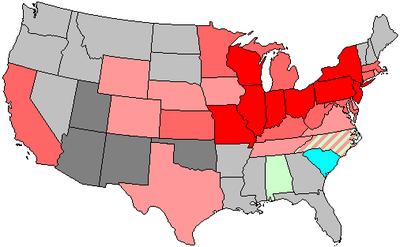1894 United States elections
 From Wikipedia the free encyclopedia
From Wikipedia the free encyclopedia
| ← 1892 1893 1894 1895 1896 → Midterm elections | |
| Election day | November 6 |
|---|---|
| Incumbent president | Grover Cleveland (Democratic) |
| Next Congress | 54th |
| Senate elections | |
| Overall control | Republican gain |
| Seats contested | 30 of 88 seats[1] |
| Net seat change | Republican +2[2] |
| House elections | |
| Overall control | Republican gain |
| Seats contested | All 356 voting seats |
| Net seat change | Republican +110[2] |
 | |
| 1894 House of Representatives election net gains by state 6+ Republican gain 3 to 5 Republican gain 1 to 2 Republican gain 1 to 2 Populist gain 1 to 2 Democratic gain Territory | |
The 1894 United States elections was held on November 6, and elected the members of the 54th United States Congress. These were mid-term elections during Democratic President Grover Cleveland's second term. The Republican landslide of 1894 marked a realigning election In American politics as the nation moved from the Third Party System that had focused on issues of civil war and reconstruction, and entered the Fourth Party System, known as the Progressive Era, which focused on middle class reforms.[3]
The Democrats suffered a landslide defeat in the House losing over 100 seats to the Republicans[4] in the single largest swing in the history of the House. The Democrats also lost four seats in the Senate,[5] thus resulting in the President's party completely losing control of both houses of Congress, the first time this ever happened in a midterm election.
The Democratic Party losses can be traced largely to the Panic of 1893 and the ineffective party leadership of Cleveland. Republicans effectively used the issues of the tariff, bimetallism, and the Cuban War of Independence against Cleveland. The Democrats suffered huge defeats outside the South (almost ninety percent of Northeastern and Midwestern House Democrats lost re-election), and the Democratic Party underwent a major turnover in party leadership. With the defeat of many Bourbon Democrats, William Jennings Bryan took the party in a more populist direction starting with the 1896 elections.[6]
Federal[edit]
States[edit]
- 1894 Nebraska gubernatorial election
- 1894 South Carolina gubernatorial election
- 1894 Pennsylvania gubernatorial election
See also[edit]
- 1892 United States presidential election
- 1892 United States House of Representatives elections
- 1892–93 United States Senate elections
References[edit]
- ^ Not counting special elections.
- ^ a b Congressional seat gain figures only reflect the results of the regularly-scheduled elections, and do not take special elections into account.
- ^ Walter Dean Burnham, "The system of 1896: An analysis." in Paul Kleppner et al. The evolution of American electoral systems (1981): 166-69.
- ^ "Party Divisions of the House of Representatives". United States House of Representatives. Retrieved 25 June 2014.
- ^ "Party Division in the Senate, 1789-Present". United States Senate. Retrieved 25 June 2014.
- ^ Busch, Andrew (1999). Horses in Midstream. University of Pittsburgh Press. pp. 63–71.
Further reading[edit]
- Jensen, Richard J. (1971). The Winning of the Midwest: Social and Political Conflict, 1888-1896. U of Chicago Press. p. 209ff. ISBN 9780226398259.
- Lewis, J. Eugene. "The Tennessee Gubernatorial Campaign and Election of 1894." Tennessee Historical Quarterly (1954): 99–126. in JSTOR
- McCormick, Richard L. From Realignment to Reform: Political Change in New York State 1893-1910 (1981).
- Petersen, Eric Falk. "The End of an Era: California's Gubernatorial Election of 1894." Pacific Historical Review 38.2 (1969): 141–156. in JSTOR